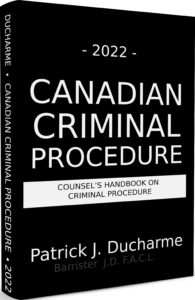 |
| Patrick J Ducharme |
The accused is often required to proceed with a judicial interim release hearing knowing very little about the specific allegations that form the basis of the charge(s). The reason for this is that disclosure of that information to the accused, now required as of right at or near the time when the accused will enter his plea, is often not available in any completed form at the time of the bail hearing.
The evidence provided at the bail hearing is often provided by an officer who did not participate personally in the investigation of the offence(s). The testifying officer is usually an officer who may have spoken to the investigating officers but may not even have their reports at the time the testimony is presented to the presiding Justice. This second-hand version of the evidence is often less accurate and less detailed than the evidence presented at trial.
Section 518 of the Code permits evidence to be admitted at the bail hearing that either would not be admissible at trial, or, would require further evidence from the prosecutor to make it admissible at trial.
Section 518 permits the following evidence at a bail hearing:
the presiding Justice may make inquiries on oath concerning the accused as he considers desirable, with one exception, that the accused shall not be examined by the Justice or any other person except counsel for the accused respecting the offence with which the accused is charged, and, no inquiry shall be made of the accused respecting that offence by way of cross- examination unless the accused has testified respecting the offence;
the prosecutor may lead evidence to prove that the accused has previously been convicted of a criminal offence. This would not be permitted at trial unless the accused provided evidence under oath at trial.
the prosecutor may lead evidence to prove that the accused has been charged with and is awaiting trial for another criminal offence.
the prosecutor may lead evidence to prove that the accused has previously committed an offence under section 145 (a previous breach of a bail condition).
the Justice may consider wiretap evidence incriminating the accused orally or in the form of a recording without the requirements of section 189(5) making this evidence inadmissible at trial unless the prosecution has provided the accused reasonable notice of her intention to use such evidence and has provided a transcript of the alleged wiretap communications and a statement respecting the time, place and date of the private communications and the identity of the parties on the wiretaps.
the Justice may consider any evidence submitted regarding the need to ensure the safety or security of any victim or witness to an offence.
the Justice may receive and base her decision on evidence considered credible or trustworthy, a test that is far more lenient in permitting evidence to be admissible that might not, and probably would not, be admissible at trial.
The presiding Justice at a bail hearing is not required to follow all the strict rules of admissibility that are in place at trial.

The above is the an excerpt of Patrick J Ducharme's book, Canadian Criminal Procedure, available at Amazon or in bulk through MedicaLegal Publishing along with Criminal Trial Strategies.
Subscribe to Patrick Ducharme's Youtube Channel
